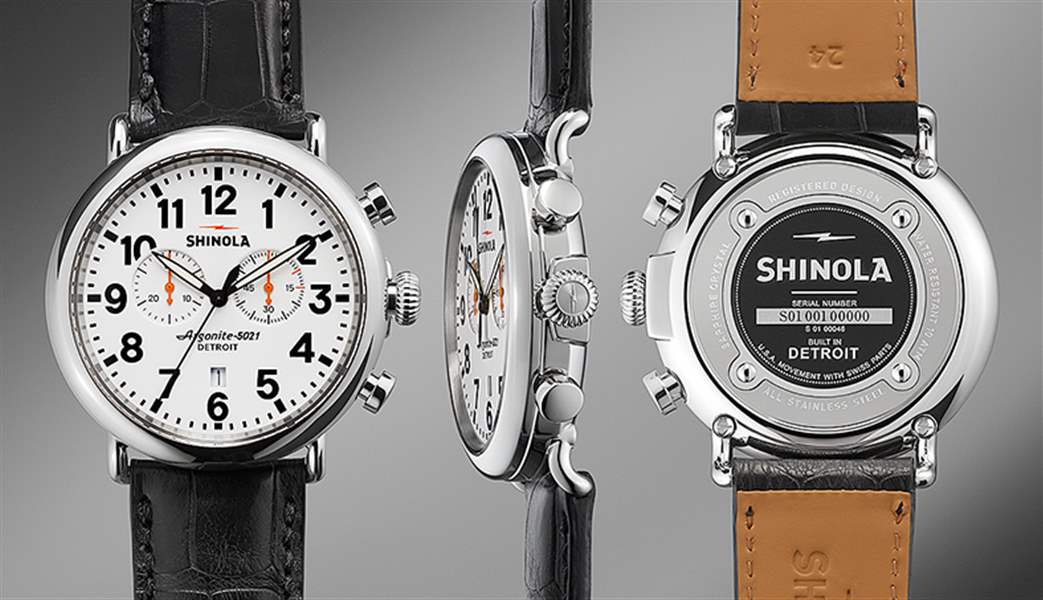
COMMENTARY
Toledo is losing the branding battle
The region’s branding initiative needs to dig deeper, and wider, into the community
1/19/2014
Shinola, a Detroit company that makes high-quality watches, has used the city’s brand to boost sales.
HANDOUT. NOT BLADE PHOTO.

Jeff Gerritt
Branding a city might seem trivial, but in an obsessively self-promoting nation, it matters.
Consider Shinola. Since 2011, the upscale watch company has manufactured in Detroit, once the nation’s industrial center and now a paragon of grit and resilience that, coupled with its stirring history, has created one of the nation’s strongest brands.
Stamped with Detroit’s name, Shinola watches sell for $500 to $1,000. Despite a production capacity of 50,000 watches a year, Shinola’s factory north of downtown struggles to keep up with growing demand. Sure, Shinola makes quality stuff, including bikes and leather goods, but the Detroit brand is part of its success story.
The vice president of the Toledo Regional Chamber of Commerce recently said a similar company could duplicate Shinola’s success in Toledo.
Probably not.
No doubt, Toledo has the transportation system, work force, and infrastructure to nurture a company such as Shinola. But it doesn’t have the Detroit brand, which Shinola, in high-gloss ads, smartly exploits.

Rising-star rapper Danny Brown laces his lyrics with references to his hometown of Detroit.
So does Chrysler. And so does rising-star rapper and Detroit native Danny Brown. Like other rappers, he laces his lyrics with hometown references, wrapping himself in the flag and imagined persona of his city.
Branding can sell albums, watches, cars, and cities. It can even help elect presidents.
In her new book, The Power of Glamour, Virginia Postrel defines glamour as an “imaginative experience in which communication and association create a recognizably consistent emotional response.” That also defines branding.
It can tell more about what a place wants to become than what it is. Like most cities, Grand Rapids, Mich., is highly segregated by race and class, and it has one of the state’s worst public school systems. Yet it has adroitly branded itself as a progressive, hip, and arty spot, with great mass transit.
Outside of northern Ohio, Toledo does not trigger, as Ms. Postrel puts it, a “consistent emotional response.” After I moved here from Detroit last year, people asked me what were my impressions of Toledo before I came. Truth be told, I had none — good or bad.
Affordable and safe with good city services, Toledo is a livable city, but that alone doesn’t give it an alluring brand.
I don’t have the answer, but the people leading Toledo’s branding initiative need to dig deeper and wider into the community. They need a jolt. The narrated videos of “EconCat88,” many of them portraying Toledo as a wasteland, probably did more to get people talking about the city’s image than a branding initiative that’s more than four years old.

Shinola, a Detroit company that makes high-quality watches, has used the city’s brand to boost sales.
The good news is Toledo Region Brand Manager Jeff Schaaf, who has had the job for only a year, understands that his coalition needs to broaden the conversation. He told me last week that the group started by focusing on economic development, touting the region’s financial and business advantages. Now, in the next phase, it’s trying to capture and convey what makes living in Toledo enjoyable and enriching: entertainment, music, sports, colleges and universities, street art venues, the zoo, cultural institutions, parks, and so on.
The coalition aims not to define the full brand for Toledo, but to provide tools, including marketing images, to help area businesses, agencies, and institutions promote and brand themselves. It plans to release a promotional video this year.
That’s all good, but the community life phase of branding Toledo should have started long before Mr. Schaaf took the job.
In reaching out, branders should not limit themselves to formal organizations or established channels. They must reach a greater diversity of people, not just Toledo’s shot callers and the usual suspects. A few months ago, I learned more about Toledo’s strengths and weaknesses by talking to teenagers and young adults at Soul City in Toledo’s central city than I have from the mayoral campaign or the branding initiative.
Toledo cannot — and should not — try to copy other cities, but it does need to embrace urban life, including its grit. Many young people moving into downtown Detroit grew up in the suburbs, or ex-burbs. They’re looking for something edgier, and they want to be able to walk to clubs and shops. Toledo is no different.
When financial calamity threatened to eclipse Motown’s iconic history, Detroiters took the barrage of negative history and flipped it, turning adversity into a hopeful, hardknock comeback story. Toledoans must become equally determined.
They might find a touchstone in the city’s cultural life. Toledo has not only a world-class art museum but also a vibrant art community, including musicians, public artists, and street and mural artists.
Why not get these young — and not so young — creative people together and see what they come up with? Launch an innovative social media campaign. Encourage people, as one city councilman suggested, to create their own videos of Toledo and post them online. Get public high school students on the grind. Create a promotional video of Toledo, scored with music from a rap and rock group, as well as the Toledo Symphony: Toledo, the city where people play together.
TARTA, the regional mass transit agency, also needs to get involved. Transit is inherently regional, and few services do more to improve lives, create jobs, and attract people, including younger people who aren’t addicted to vehicles.
One speaker last year suggested that Toledo has an identity crisis. In coming together to work on a branding, the city might even find out what — and who — it is.
Jeff Gerritt is deputy editorial page editor of The Blade.
Contact him at: jgerritt@theblade.com, 419-724-6467, or follow him on Twitter @jeffgerritt.